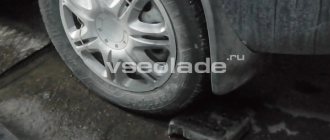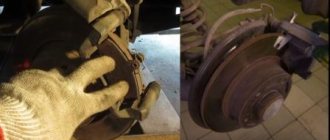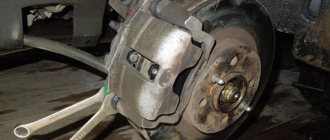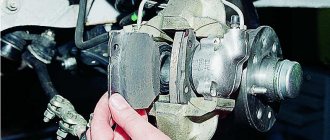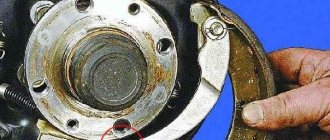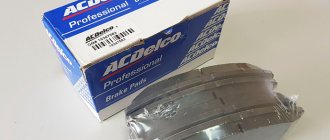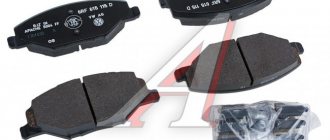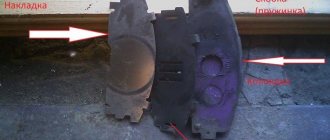Braking of the car is carried out due to the brake pads - they are rear and front. Under pressure, they are pressed against the disc or drum, in the case of rear brakes, as a result of which the car stops. The brake system is one of the most important, since the safety of everyone in the car depends on its good condition. Keeping your brakes in good working order is a very important task. One of the main stages of ensuring their serviceability is the timely replacement of pads.
Replacing front brake pads on Lada Vesta
The braking system of any car, including the Lada Vesta, is one of the most important, since the safety of not only the car’s passengers, but also other road users directly depends on it. This means that maintaining the brake system in good condition is always a priority. Timely replacement of brake pads is aimed at this.
Replacing Vesta brake pads yourself is not just a way to save on service station services, but also an excellent opportunity to work on your car yourself.
The pads are frozen, the ABS signal is on - how to fix it
Most often, the PTC or ZTK jams after washing in cold weather or heavy snow accumulation under the brake system sensor. When the car starts, the control unit recognizes a sticking error and signals it with a yellow indicator on the dashboard.
It is quite easy to fix the defect on your own, repeat the following steps:
- Start the engine.
- Engage reverse gear.
- Increase the speed, back up a few meters.
- A similar distance forward.
The indicator on the dashboard should go out and the sensor should return to its original position. If the recommendations do not help, wash the PTC with a stream of warm water at a car wash, contact an authorized dealer to have the breakdown repaired.
Pad selection
First you need to buy a set of brake pads.
Important! The pads on the same axle must be changed at the same time. Otherwise, Vesta may be pulled to the side during braking.
There are a lot of options on the market now, so before purchasing, it is recommended to evaluate them and choose the most suitable ones - both in terms of price and quality, as well as driving style. During the factory assembly process, VESTA is equipped with pads from the TRW brand. Their catalog number is 8200 432 336.
The photo shows different brands
There are several simple criteria that the pads must meet:
- No cracks;
- Deformation of the support plate is unacceptable;
- The friction material must be free of foreign bodies;
- It is advisable not to buy pads that contain asbestos.
The most popular options for brake pads for Lada Vesta are presented in the table
As you can see, there are a lot of products, and not all of them are reflected in the table, because there are also products from FORTECH, Nibk and others.
This video provides recommendations for choosing brake pads for Vesta
Characteristics of Vesta's standard brake pads
From the factory, Vesta is equipped with a ventilated disc braking mechanism at the front and drum-type brakes at the rear. The catalog number for the standard front pads is 8200 432 336 TRW, they were borrowed from Renault Logan. The front and rear brake consumables are metal plates with special material. Thanks to it, friction against the disc or drum becomes most effective for braking.
Typically, rubber with the addition of resins, organic fibers, and other fillers is used to make this material. The chemical composition of Lada Vesta pads is quite complex. This is explained by the fact that the coating must withstand the high temperature conditions in which it remains during friction with the metal.
As for the rear brakes of the Lada Vesta, AvtoVAZ offers a disc option only in the Sport version.
Sports cars are not equipped with an anti-lock braking system; besides, the wheels allow you to deal with skids much more effectively. In favor of the rear drums, we can say that they are more durable, and for the civilian version of the car they are quite effective and do not cause any complaints.
Installation
Replacing brake pads on a Lada Vesta yourself is not difficult. First you should prepare for work.
- Slotted screwdriver;
- Key to 13;
- Key for 15.
First you need to open the hood and check the brake fluid level in the reservoir. If it is at the Max mark, you will need to pump out the part using a syringe so that when the piston is retracted into the cylinder, the brake fluid does not flow over the edge. When this is finished, all that remains is to jack up the Vesta and remove the wheel. Don't forget to put a support on it for security.
The first step is to press the piston into the cylinder. To do this, a slotted screwdriver is inserted between the piston and the brake pad (inner), which presses the piston. However, you need to work carefully so as not to damage the cylinder boot, otherwise it will have to be replaced.
First we press the piston into the cylinder.
Then we proceed to unscrew the bolt that secures the brake caliper with the guide pin (lower). The pin itself is held with a 15mm wrench, while the bolt is unscrewed with a 13mm wrench.
Next, lift the brake caliper up. The brake fluid supply hose does not need to be disconnected.
Once the caliper is lifted, all that remains is to remove the worn out brake pads and remove the spring calipers. There are probably traces of corrosion and dirt on them and on the seats for the pads - they need to be cleaned with a metal brush.
Before installing new pads, it is necessary to inspect the condition of the guide pin boots. If the cover is defective (crack, etc.), the pin must be removed and the boot itself must be replaced. The lower finger simply unscrews, but if you need to put a new boot on the upper finger, then when unscrewing it, you will have to remove the brake caliper itself. When installing the pins back, you need to apply a little lubricant to them.
After checking, all that remains is to install new pads and secure them with spring clips. Assembly is carried out in reverse order.
Work with the second wheel is carried out in the same way.
When replacing the brake pads on Vesta is completed, all that remains is to press the brake pedal several times and also check the brake fluid level in the reservoir. If it is less than normal, you need to top it up.
The video clearly demonstrates the process of replacing pads on Vesta
Mechanics recommend that after replacing the pads on the Vesta, drive carefully and steadily for at least the first 100 km (or better yet, 500 km). Braking should be done smoothly to allow the new pads to get used to the brakes.
Replacing the pads on Vesta yourself does not take much time; moreover, the work does not require specific tools and skills. Therefore, it will be an excellent opportunity to work on the car yourself and save money, because service stations charge about 500 rubles for a replacement.
Source
Inspection of the Lada Vesta engine
After removing the plastic protective casing from the top of the engine, it was clear that in just a few hundred kilometers the Lada Vesta engine was fairly covered in dirt, which seeped from under the bottom and through the radiator grille. In general, engine compartment seals do not help cope with dirt. The procedure for changing the oil on the new VAZ-21129 engine, which has become a modified version of the VAZ-21127 engine, known to us from the Lada Granta, Kalina and Priora models, will be quite simple. True, it is still difficult to get to the oil filter. It is expected that with such efforts, the cost of changing engine oil in Russian car services will cost about 700-800 rubles. Access to the engine spark plugs is also simplified. They will need to be unscrewed with a special key with a Torx head. In this case, work on replacing spark plugs can cost 500 rubles, as stated by car service specialists. But car service workers estimated the replacement of the timing belt at as much as 5,000 rubles. This is due to the fact that the belt has a tension pulley instead of the alternator brackets.
Lada Vesta: replacing the brake pads of the front wheels
February 18, 2022 Lada.Online 159 653 34
Unlike rear brake pads, front brake pads are replaced more often. This is due to the fact that they bear the main load during braking. Not only the braking efficiency, but also whether they will creak during operation depends on the quality of the brake pads. Do you know which pads are best for Vesta?
Original front brake pads
- 8200432336 or 410608481R Renault, price about 1850 rubles.
- 8450108101 "TIIR" JSC, Yaroslavl, price about 1150 rubles.
- 8450038536 "Lada-Sport" LLC, Tolyatti, price about 2750 rubles. (Lada Vesta Sport)
- TRW - GDB 3332
- Brembo - P68033
- Motrio LS-KTLL
- UBS Performance BP11-05-007
- MILES - E100108
- REMSA - 0987.00
- FERODO - FDB1617
- ASAM - 30748
- HI-Q Sangsin Brake – SP 1564
- LYNXauto - BD5739
- SAT - ST4106000Q0K
- Hagen Sangsin Brake - GP 1564
- Blitz - BB0292
- Galfer - B1G10207412
- ATE - 13.0460-2709.2
- Zekkert - BS-1221
- Trialli PF1402
- and etc.
Original rear disc brake pads
- TRW GDB1384
- Sangsin Brake SP1709
- UBS - B1105007
- Brembo P23064
The brake pad consists of a metal plate and a special lining made of friction materials. The quality of this material determines the wear resistance, rigidity and friction coefficient of the brake pad. The higher these important parameters, the better.
Reviews
| № | Positive |
| 1. | Valery , 43 years old (www.otzovik.com): drove over 53,000 km, did not change the PTC. |
| 2. | Kirill , 39 years old (www.zr.ru): at 26,000 km the PTC creaked for the first time, visited a service station, replaced it with new ones under warranty. |
| 3. | Vitaly , 23 years old (www.autobann.su): the pads squeak only after washing or long trips through puddles. When dry, there are no external sounds. |
| 4. | Georgy , 33 years old (www.lada-vesta.net): the car is two years old from the date of purchase, no capital investments, the systems are working as normal. |
| 5. | Vladlen , 41 years old (www.otzovik.com): there are no comments on the brake circuit, unlike the Lada Grant, the Vesta has good brakes. |
| 6. | Dmitry , 43 years old (www.zr.ru): I won’t praise the car, the system periodically fails, but for me this is not important. |
| 7. | Vitalievich , 25 years old (www.autobann.su): comrades advise installing the PTK from Renault Logan of the second generation, they say, the quality is better there. For now I’ll go with domestic ones. |
| 8. | Zheka , 33 years old (www.lada-vesta.net): when a metallic creak of the pressure plate appears, it means it’s time to replace the PTC. |
| 9. | Konstantin Vladislavovich, 49 years old (www.otzovik.com): my pads lasted over 75,000 km, I think this is a good result. |
| 10. | Leonidovich , 33 years old (www.zr.ru): the car is three years old, I carry out most of the maintenance work myself, and rarely call for service. |
| 11. | Vasily, 36 years old (www.autobann.su): my positive review of the car, good build, decent quality, affordable price. |
| Negative | |
| 12. | Ivan , 42 years old (www.zr.ru): the first time the PTK flew 40,000 km, although the service life according to the instructions is 65 - 70 thousand km. |
| 13. | Vitaly , 38 years old (www.otzovik.com): extremely dissatisfied with the quality of the brake system on the Lada Vesta, in Renault Logan, Megan the circuit is better implemented. |
| 14. | Ivan Vasilyevich , 47 years old (www.autobann.su): I do not recommend buying the model, there are many flaws, defects, it requires investment at the initial stage. |
Standard front pads - article number and price
On a Lada Vesta car of any modification and in any body, consumables manufactured by Renault are installed - be it a sw station wagon, sw cross, sport, etc. On the Lada Vesta St. Cross, the consumable parts can withstand the load - they wear out at the same rate as on other modifications.
Standard components of the Lada Vesta brake system received catalog number 8200 432 336. Their cost in stores starts at 1,400 rubles and ends at approximately 2,000 rubles.
↑ Influence of operating conditions
The job of brake pads is to constantly resist wear by making firm contact with rotating surfaces. That is why special materials are used to make the rear and front brake pads of the Lada Vesta model, as well as other cars.
If the driver does not imagine himself as a Formula 1 pilot and does not practice start-stop driving, then the driving and braking style itself is unlikely to have a significant impact on accelerated failure: rather, incorrect installation of the plates, their uneven fit to the disc ( drum). This defect can be eliminated by carrying out maintenance of the caliper, inspecting the surface of the pads and checking the cylinders for piston stroke.
Standard rear brake pads - article number and price
The article number for a set of original pads comes in two types – for drum and disc brakes. The catalog number of the kit for the VAZ Lada Vesta with disc brakes is 11196-3502089-00. It costs about 2000 rubles.
Drums
The kit catalog number for the version with drum brakes is 8450076668. It will cost 4,000 rubles, but, again, it will last longer.
Complete set with calipers
Disc brakes complete with calipers are not sold everywhere, but you can purchase additional calipers. Article - 11196350201100, cost - from 9000, produced by AvtoVAZ.
Inspection of the Lada Vesta chassis
Surprisingly, the Lada Vesta has a steering rack with the AvtoVAZ marking and the inscription Made in Malaysia. It was also discovered that the ball joint is held to the subframe by a rivet. As a result, replacing such ball joints will be complicated and will cost about 2,000 rubles. Car service workers will have to cut off the rivets and then install them. In the rear suspension everything is quite simple - an ordinary harsh beam. Any motorist using a jack can replace the shock absorbers and springs in the rear suspension himself. Service specialists said that replacing two rear suspension shock absorbers will cost about 2,000 rubles. The new Lada Vesta sedan is equipped with TRW brake pads. Car service specialists said that this company has a high reputation. To replace the front and rear pads, car service specialists will charge an average of 700 rubles for the front pads and 1000 rubles for the rear pads.
Discs and drums
Disc brakes, which are installed on the front wheels of the new Lada Vesta sedan, operate on the principle of pads. The discs are manufactured in such a way that they receive good cooling and avoid excessive heating, which can negatively affect their performance and driving safety.
Advantages of disc brakes on Lada Vesta:
- they are better cooled due to constant ventilation and air circulation;
- discs quickly get rid of water and dirt that regularly fall on them;
- The location of the disc brakes on the front wheels gives the car an advantage in braking speed, thanks to which the driver avoids many dangerous situations on the road.
The rear wheels of the Lada Vesta have drum brakes. They, like disk ones, comply with all modern international quality standards and ensure the safety of car owners. The drum system is better suited for driving on bad roads and off-road.
Such brakes work more effectively on unpaved, muddy and dusty roads. They work well even in the most unpleasant weather conditions for the Lada Vesta, but also function well on asphalt.
The combination of drum and disc systems allows the Lada Vesta driver to feel confident on any road, regardless of weather conditions and other external factors. The brakes work with equal efficiency both during fast and quiet driving.
How does Lada take care of your safety?
Lada Vesta has a special adaptive system in its arsenal, which is designed to ensure maximum convenience of the braking process. The car has built-in electronics that determine how fast and how hard the driver presses the pedal. This allows you to achieve the fastest and most timely stopping of the car in any situation. The computer has an instant response and takes care of the safety of the driver of the Lada Vesta continuously throughout the entire trip.
Lada Vesta is also equipped with a built-in electronic system designed to distribute forces. It turns on at the moment when the load on the disc and drum brakes goes beyond the established norm. This system redistributes the load level, and Lada Vesta continues to move without skidding.
In addition to all the innovations listed, the Lada Vesta has a directional stability system, which is responsible for the following vehicle functions:
- if necessary, certain (depending on the situation) wheels of the Lada Vesta independently brake and create optimal conditions for movement;
- torque may vary;
- the front wheels of Lada Vesta are independently redirected in the correct direction.
Such properties allow the Lada to keep the right course during sharp turns. The trajectory of movement does not deviate from the norm due to the braking of the rear wheel located inside. The use of this technology allows the driver to have good control of the Lada Vesta at all times.
Basic faults
If we exclude the possible defective parts and poor quality from the manufacturer, then the main reason why the front pads on the Lada Vesta become unusable is wear. They actively interact with other parts of the brake mechanism, and therefore a look at the nature of damage to the friction linings will make it clear what is wrong with the operation of the brake system. By correcting this error, you will increase the service life of not only the pads, but also the entire mechanism.
The nature of the malfunctions can be noted:
- Uniform wear - it manifests itself in the fact that the friction layer is worn evenly, this shows that the brakes are working well.
- Severe wear of the friction layer, brake rivets are visible - this means that you have been using the “outdated” parts for too long. The rivets could damage the disc, so it would be a good idea to inspect it for damage.
- The friction layer is worn evenly around the entire circle, but one of the sides is worn out more than the other - one of the parts of the brake system (guide or piston) does not distribute the braking force correctly. Cleaning all “live” parts and applying a new layer of lubricant will help. Naturally, everything will have to change.
- Both components are worn unevenly, the surface is strewn with irregularities and roughness. The reason for this outcome is a malfunction of the caliper guide pins - they swing and do not give an even trajectory of movement. You will have to clean them, then reapply lubricant.
- The friction lining is cracked - in this case, the “trouble” is caused by the brake discs themselves - they wear unevenly. Everything will have to change.
- Uneven wear of the friction layer means that the parts were installed incorrectly. They will have to be changed.
After performing a visual inspection of the damage, you can independently make a verdict about the breakdown. And besides this, there are several other signs by which you can find out about a faulty front pad while sitting behind the wheel.
Creak
If a squeaking noise occurs from the front when braking, this means that the pad and disc are not mating. This happens when a cheap analogue was purchased to replace the original component. But not everything is so bad - sometimes this analogue can last a long time, but the real reason is dirt that has gotten into the moving parts and reduces the contact area of the moving parts.
Vibration at speed: what is it?
Vibration at speed appears when the pads do not fit the discs - there is some incompatibility that does not manifest itself in the operation of the “original” parts. If, when braking, you still get “full contact” of these parts of the brake mechanism, this means that the wear of the hub discs themselves is haunting, and they will have to be replaced.
Rear brake discs
The table below shows the parameters of the rear disk.
| Disk option | Meaning |
| Type | Hollow |
| Thickness | 11 |
| Minimum thickness | 9 |
| External diameter | 260 |
| D location of mounting holes | 100 |
| Number of mounting holes | 4 |
| Bolt pattern | 100*4 |
| D centering | 66 |
| Height | 45.7 |
| D mounting holes | 13 |
Original
The original rear brake discs have part number 8450031131 . Discs are also sold individually rather than in pairs. They cost less than the front one and will cost about 3-3.5 thousand rubles per disc.
Analogs
The table shows analogs of disks that users most often respond positively to, and they also cost much less than the original.
| Name | vendor code | Estimated cost per pair (rubles) |
| Valeo | 297764 | 2000 |
| Jurid | 561997 jc | 2000 |
| N.K. | 202264 | 1500 |
Most owners of these cars note that it is best to use original discs, as they cause fewer problems and work efficiently.
What types of brake pads are there?
In total, the following types of brake pads are distinguished:
- Polymetallic (they consist of 35 to 65% metal, have a long service life and have high thermal conductivity. However, they can make noise, damage the rotor and react with reduced performance at sub-zero temperatures).
- Organic (they are made from a fibrous base such as rubber, glass or carbon. When used, these elements are quiet because they have a soft base, but they wear out faster and become covered with dust faster).
- Low-metal (made from an organic medium with the addition of steel or copper, which improves heat transfer and braking speed. Their disadvantage is that if the base contains a large amount of metal, the brake pads make a lot of noise and quickly gather dust).
- Ceramic (the highest quality brake pads, which are made of ceramics. They are very quiet, do not get dusty and are very expensive).
What pads should I put on Vesta?
We do not recommend buying the cheapest pads; they creak, brake poorly and wear out the disc a lot. Below in the table is a list of manufacturers and article numbers of pads that are best suitable for the Lada Vesta.
| Manufacturer | vendor code | price, rub. |
| Original | 8200 432 336 | 2000 |
| Hi-Q | SP1564 | 1250 |
| Brembo | P 56 086 | 2000 |
| TRW | GDB 3396 | 2300 |
| Bosch | 0 986 494 160 | 2600 |
Which front pads are better for Vesta?
In general, all the pads from the above list are good. Speaking specifically, most Vesta owners advise installing the original. Its disadvantage is the inflated price tag. But you can also supply a direct analogue from the manufacturer’s supplier - TRW. Their advantage is that they do not generate dust and are quite strong. It is also worth remembering that the original spare part and its direct analogue from the manufacturer may differ in quality.
Removing and installing front pads
Before starting work, prepare the following tools:
- Keys for 13 and 15;
- Brake system parts cleaner (a regular rag will not be able to completely remove dirt and used lubricant residues);
- Flat screwdriver;
- High temperature grease.
The procedure for replacing parts is as follows:
- Secure the vehicle in place by applying the parking brake. Turn off the ignition. Raise the front of Vesta with a jack;
- Proceed to remove the wheel. Remove the cap, loosen the bolts one turn. Continue this action in a circle with all the bolts;
- Remove the brake fluid reservoir cap and pump out a few milliliters. This will prevent the liquid from coming under pressure. Press the brake cylinder inward with a screwdriver;
- Use a 15mm wrench to hold the caliper guide pin, and use a 13mm wrench to remove the two bolts. Do not let the free part of the caliper fall to the ground;
- Pry up the outer pad with a screwdriver and carefully remove it. In the same way, remove the inner block;
- The spring retainer, which is responsible for uniform wear, will have to be cleaned and then re-coated with lubricant;
- Install a new part - first the external one, then the internal one;
- Clean the guides and also coat them with lubricant;
- Put all the parts back;
- Tighten the fastening bolts, install the wheel, clockwise, one rotation at a time, secure all the bolts.
What front brake pads can be installed on the Lada Vesta - manufacturers, analogue prices
The following analogues of front pads are common:
- Front brake pads HI-Q Sangsin Brake (SP 1564) – 1400 rubles;
- SAT (ST4106000Q0K) – 450 rubles;
- Brembo (P68033) – 1600 rubles;
- Galfer (B1G10207412) – 1250 rubles;
- Zekkert (BS-1221) – 700 rubles;
- Blitz (BB0292) – 750 rubles;
- Hagen Sangsin Brake (GP 1564) – 1400 rubles;
- UBS (BP1105007) – 1500 rubles;
- ATE (13.0460-2709.2) – 1700 rubles;
- LYNXauto (BD5739) – 850 rubles;
- TRW (GDB 3332) – 1700 rubles.
Popular products of the spare parts group - Brake pads for LADA VESTA (GFL_)
Brake system LADA VESTA (GFL_) Front disc brake pads Renault Clio III/Logan I/Modus/Grand Modus 04>14 Nissan Micra III/Note/Tiida 03>12 Dacia Logan 05>MK KASHIYAMA D1261H
manufacturer: MK KASHIYAMA (Japan) article: D1261H
Brake system LADA VESTA (GFL_) Front disc brake pads Renault Clio III/Logan I/Modus/Grand Modus 04>15 Nissan Micra C+C III/Micra III/Note 03>12 GIRLING 6120171
manufacturer: GIRLING (Germany) article number: 6120171
Brake system LADA VESTA (GFL_) Front disc brake pads Renault Clio III/Logan I/Modus/Grand Modus 04>15 Nissan Micra C+C III/Micra III/Note 03>12 Dacia Logan/Logan MCV 05>FERODO FDB1617
manufacturer: FERODO (Great Britain) article: FDB1617
Brake system LADA VESTA (GFL_) Front disc brake pads Renault Clio III/Logan I/Modus/Grand Modus 04>15 Nissan Micra C+C III/Micra III/Note 03>12 FINWHALE V1067
manufacturer: FINWHALE (Germany) article: V1067
Brake system LADA VESTA (GFL_) Front disc brake pads Renault Clio III/Logan I/Modus/Grand Modus 04>15 Nissan Micra C+C III/Micra III/Note 03>12 WEEN 1511333
manufacturer: WEEN (Netherlands) article number: 1511333
Brake system LADA VESTA (GFL_) Front brake pads Renault Clio III/Logan I/Modus / Grand Modus 04>14 Nissan Micra C+C III/Micra III/Note 03>12 Lada Largus / 12> FRIXA FPE127
manufacturer: FRIXA (Korea) article number: FPE127
Brake system LADA VESTA (GFL_) Front disc brake pads Renault Clio III/Logan I/Modus/Grand Modus 04>15 Nissan Micra C+C III/Micra III/Note 03>12 ALLIED NIPPON ADB0984
manufacturer: ALLIED NIPPON (Japan) article number: ADB0984
Brake system LADA VESTA (GFL_) Front disc brake pads Renault Clio III/Logan I/Modus/Grand Modus 04>15 Nissan Micra III/Note/Tiida 03>12 Dacia Logan MCV 07>HI-Q (SANGSIN) SP1564
manufacturer: HI-Q (SANGSIN) (Korea) article number: SP1564
Brake system LADA VESTA (GFL_) Front disc brake pads Renault Clio III/Logan I/Modus/Grand Modus 04>15 Nissan Micra C+C III/Micra III/Note 03>12 TRIALLI PF1416
manufacturer: TRIALLI (Italy) article number: PF1416
Brake system LADA VESTA (GFL_) Rear disc brake pads Fiat Panda/Punto/500 99>13 Lada Vesta/Vesta SW/Xray 15> Citroen E-Mehari 16> TEXTAR 2360102
manufacturer: TEXTAR (Germany) article number: 2360102
Brake system LADA VESTA (GFL_) Front disc brake pads Renault Clio III/Logan I/Modus/Grand Modus 04>14 Nissan Micra C+C III/Micra III/Note 03>12 Dacia Logan/Logan Express/Logan MCV 07>18 Suzuki Swift III 05>NIBK PN9805
manufacturer: NIBK (Japan) article number: PN9805
Brake system LADA VESTA (GFL_) Front disc brake pads Renault Clio III/Logan I/Modus/Grand Modus 04>15 Nissan Micra C+C III/Micra III/Note 03>12 NISSHINBO NP2040
manufacturer: NISSHINBO (Japan) article number: NP2040
Brake system LADA VESTA (GFL_) Disc brake pads Renault Clio III/Logan I/Modus / Grand Modus 04>14 Nissan Micra C+C III/Micra III/Note 03>12 Lada Largus / 12> PILENGA BMFD8010
manufacturer: PILENGA (Italy) article number: BMFD8010
Brake system LADA VESTA (GFL_) Front disc brake pads Renault Clio III/Logan I/Modus / Grand Modus 04>14 Nissan Micra C+C III/Micra III/Note 03>12 Lada Largus / 12> ZEKKERT bs-1221
manufacturer: ZEKKERT (Germany) article number: bs-1221
Brake system LADA VESTA (GFL_) Front disc brake pads Renault Clio III/Logan I/Modus/Grand Modus 04>15 Nissan Micra C+C III/Micra III/Note 03>12 ROADHOUSE 298700
manufacturer: ROADHOUSE (Spain) article number: 298700
Brake system LADA VESTA (GFL_) Front brake pads Renault Clio III/Logan I/Modus/Grand Modus 04>15 Nissan Micra C+C III/Micra III/Note 03>12 GIRLING 6133321
manufacturer: GIRLING (Germany) article number: 6133321
Brake system LADA VESTA (GFL_) Front brake pads Renault Clio III/Logan I/Modus/Grand Modus 04>15 Nissan Micra C+C III/Micra III/Note 03>12 Dacia Logan MCV 07> LADA 410608481R
manufacturer: LADA article: 410608481R
Brake system LADA VESTA (GFL_) Disc brake pads front rear Renault Clio III/Clio III Grandtour/Modus/Grand Modus 04>15 Nissan Micra C+C III/Micra III/Note 03>12 Dacia Logan MCV 07>BREMBO P 68 033X
manufacturer: BREMBO (Italy) article number: P 68 033X
Brake system LADA VESTA (GFL_) Front disc brake pads Renault Clio III/Logan I/Modus/Grand Modus 04>15 Nissan Micra C+C III/Micra III/Note 03>12 ICER 181534700
manufacturer: ICER (Spain) article number: 181534700
Brake system LADA VESTA (GFL_) Disc brake pads Renault Clio III/Clio III Grandtour/Modus/Grand Modus 04>15 Nissan Micra C+C III/Micra III/Note 03>12 Dacia Logan MCV 07> MINTEX MDB2595
manufacturer: MINTEX (Great Britain) article number: MDB2595
You can also see all spare parts for LADA VESTA (GFL_)
Rear brake pads Lada Vesta - replacement
The moment to replace and repair the rear pads on a car is determined by the fact that they are in a state of maximum permissible wear. You should also start planning a replacement if the linings are oily, or if chips, cracks and damage are visible on them, as well as a gap between the base of the consumable and the lining.
It is important to understand that the consumables on the rear wheels need to be changed as a set - so that the force is uniform, otherwise the car may skid when braking, and the braking itself will be ineffective. You need to install all four parts.
Replacement with calipers
Replacement with calipers is carried out in the same order, only at the stage when the entire mechanism is disassembled, using keys 13 and 15 you need to remove the caliper and put new parts in its place.
To replace rear disc pads on a Lada Vesta you need:
- Place the car on the ramp and lock it in gear;
- Bring the brake fluid level to a little less than half;
- Raise the rear of the machine and secure it with the support stand. Remove the wheel;
- Install the disc removal tool from the hub;
- Place the central part on the axle, and the rest will create pressure on the disk;
- If something won't come off, treat it with wd-40. Remove the bolt that secures the disc to the hub. Do this carefully, because if the edges of the bolt come off, it will be more difficult to remove;
- Remove the brake pads;
- Check the condition of the brake system. Put the new components in place and reassemble everything in reverse order;
- Bring the brake fluid level to about and adjust the brake pedal.
Removing and checking the front brake disc
We carry out work to prepare the car as described above.
Remove the front wheel and clean the front wheel brake.
Using a 18mm socket, unscrew and remove the bolts securing the front brake guide to the steering knuckle, remove the front brake assembly 1, Figure 4, and hang it from the suspension spring.
Checking the technical condition of the front brake disc
The brake disc cannot be ground. If there are deep scratches, the disc must be replaced. If the disk thickness is less than 19.8 mm, the disk must be replaced.
If you replace a brake disc on one side, you need to replace the brake disc on the other side as well.
When replacing brake discs, you need to replace the brake pads.
Using a Torx T40 socket, unscrew and remove two screws 3 securing the brake disc to the front wheel hub and remove the brake disc 2.
Brake disc installation
Reinstall the brake disc and secure it to the hub with two screws. The tightening torque of the screws is 12 - 16 N.m (1.2 - 1.6 kgf.m).
Install the front brake assembly onto the steering knuckle and secure it with new mounting bolts. Bolt tightening torque 91 - 120 Nm (9.1 - 12.0) kgf.m.
What rear pads are on the Lada Vesta
| Catalog article/number | Price in rubles |
| Original | |
| ATE03.0137-0394.2 | From 1600 |
| PILENGABSP8454 | From 1300 |
| Lada Vesta pads article number (analogues) | |
| FORD 1433865 | From 1100 |
| Brembo P68033 | From 100 |
| FENOX BP53013 | From 900 |
| Amiwa CD1841 | From 1100 |
| LYNXauto BS-5717 | From 1350 |
| *prices are as of 04/07/2019. | |
Before purchasing, check the catalog article numbers, check the integrity of the product, the presence of packaging, dates and batch numbers.
Try to purchase original products recommended by the manufacturer. Cheap analogues are not famous for their quality and sizing. The service life of the “non-original” part is 25–35% shorter than the factory part.
Which front brake pads are installed by default: depending on the configuration, the model is equipped with pads from Lada or Renault. The exact data is indicated in the car's operating manual.
How to choose brake pads
Car enthusiasts believe that original pads are much more efficient and durable than their numerous analogues. Standard spare parts recommended by the manufacturer are produced without the use of asbestos in a composition that has been proven to be hazardous to the environment. But many car owners are considering the option of purchasing non-original spare parts. The main criterion for this choice is the low cost of analogues. On the car parts market you can find non-original brake pads of fairly high quality, not inferior to the original. But there are many outright fakes - to avoid buying them, you should purchase spare parts and consumables in trusted places or directly from an official Lada dealer.
How to change with drums
You can remove the old ones and install new rear drum pads on the Lada Vesta using the following algorithm:
- Place the car on the overpass and turn off the handbrake. Secure the car by putting it in gear. It is better to reduce the brake fluid level and make it a little less than half of the norm.
- Raise the rear of the car slightly and secure it with a support stand. Remove the wheel.
- Using a flat-head screwdriver, rotate the ratchet nut away from you (“pushing” it along the thread). This reduces the length of the spacer bar and brings the pads together.
- Insert the chisel under the cap and use a hammer to knock down this cap protecting the drum bearing.
- Unscrew the hub bearing nut using a 30 mm socket.
- Carefully remove the brake drum along with the bearing. Notice the anti-lock brake sensor at the bottom under the ratchet nut (it looks like a small black plastic lever). Your task is not to damage it.
- Take a screwdriver, pry the release spring behind the hook, and then the stand. Take them off. Also remove everything on the front pad.
- Using the same screwdriver, pry the lower tension spring by the hook and remove it.
- Try not to damage the cylinder boots.
- Hook the upper tension spring on the hook and remove it from its engagement with the front block, and then dismantle it.
- Remove the front block and then the bar from the mechanism.
- Disconnect the end of the handbrake cable from the rear shoe lever.
- Before assembling the mechanism, the rear tip of the spacer bar must be recessed - the length of the spacer bar will be minimal.
- Brush the working surface of the drum with a wire brush to remove dust and dirt. Use the brush to avoid touching the ABS sensor reference ring.
- Install the mechanism in reverse order.
- Tighten the hub bearing nut to 175 Nm. As a recommendation, it is worth mentioning that it is better to install a new self-locking nut.
- After the work has been carried out, it is worth checking the brake fluid level in the reservoir.
- It is important to place the parts in the correct working position. Press the brake pedal several times and then hold it in the down position.
- Raise then release the handbrake (but only with the button engaged to deactivate the ratchet).
- Instead of handbrake clicks, you will hear other clicks - this is how the gap in the brake mechanism between the discs (drums) and pads is adjusted. Repeat these steps until the clicking noise disappears. If necessary, adjust the parking brake.
↑ Signs of wear
It is quite difficult to determine the time of installation of new brake plates or the characteristic signs indicating their obvious wear: in working condition, the brake system is closed for inspection, so they are most often guided by the normal mileage of the car. Sometimes a sign of an upcoming replacement can be squeaks in the front brake pads.
For those who want to tinker with their car, there are several tips for maintaining the caliper and ensuring the most uniform abrasion of the contact surfaces:
- Checking the response to the pedal in the brake cylinders of the rear and front pads of the Lada Vesta. In order for the car to stop quickly, evenly (on the left and right sides), the corresponding brake cylinders must operate synchronously. To do this, check the stroke of the piston; if it is tight, lubricate it with a special spray. There is an old-fashioned way of using castor oil - it wets contact surfaces well and does not burn out.
- Protective rubber bands must be intact, undamaged, and clean. If necessary, they are cleaned of the old lubricant coating, then a layer of fresh one is applied.
- The plates themselves do not cling to anything during movement or linger - this is an important condition. It is allowed to slightly sharpen the protruding parts with a finely cut file to meet this requirement.
2283-14-02-07 (Copy)
...and apply a thin layer of lubricant to the surface of the finger. ...and apply a thin layer of lubricant to the surface of the finger.
We install new brake pads in the pad guide and then assemble the assembly in the reverse order.
We similarly replace the pads on the other side of the car.
After replacing the pads, press the brake pedal several times to set the gaps between the pads and discs. We check the fluid level in the tank and, if necessary, bring it up to normal.
During operation, the surface of the brake disc becomes uneven, as a result of which the contact area of the new, not yet worn-in pads with the disc decreases. Therefore, during the first 100 km of driving after replacing the pads, until the new pads have broken in, be careful, as the car’s braking distance may increase, the pads may heat up more than usual, up to the appearance of light smoke and smell, especially in hot weather.
Lada Vesta: replacing the brake pads of the front wheels
Removing old pads
Let's consider the situation without using a car lift - those who have one know the replacement procedure.
We park the car on a level area with a hard surface and secure it with the hand brake. We check the brake fluid level in the reservoir and, if it is at the max mark, use a rubber bulb to pump it out to the min mark.
We install stops under the rear wheels in the “backward” direction, use a wheel wrench to loosen the fastening bolts of the front wheels, and use a jack to lift one of the axle shafts of the front part of the car. After the wheel is hanging, we install a safety stop under the body sill in case the jack falls off (if you don’t have it, you can put a spare wheel under the sill), unscrew the wheel bolts completely and remove the wheel.
We turn the steering wheel so that the desired brake disc is turned outward from under the wing. To make the description of the procedure clearer, we present the specification of the parts of the front wheel brake mechanism in a disassembled state.
Using a powerful mechanic’s screwdriver with a flat blade, we recess the piston into the cylinder as much as possible, inserting the tip into the gap between the piston and the inner block, while controlling the flow of brake fluid into the reservoir to avoid overflowing.
What can you tell by the wear of the rear brake pads?
Pad wear means:
- Wear of the friction layer;
- Damage to the friction layer (for example, cracks);
- Friction layer bevel;
- Carbon deposits on the discs or drum.
These “illnesses” can appear when:
- Light knocking sound when braking. This should not be confused with ABS;
- Poor braking efficiency;
- Whistling, grinding noise when braking;
- Dust, chips on the discs.
Any car repair operation is a treatment. But a separate operation may not be a treatment, but a concealment of the symptoms of a real disease. If consumables are changed due to their “natural death” - the mileage mark has simply reached 60,000 km, then other parts of the mechanism clearly should not be blamed for this.
But if the consumables failed earlier, then replacing them may not solve the problem, and soon you may have to change not only them, but also other parts of the mechanism. This is due to another malfunction in the mechanism:
- Insufficient brake fluid level;
- Caliper malfunction (causes uneven wear of the friction layer), insufficient amount of lubricant or unsuitable lubricant;
- Faulty guides (for example, damaged boot);
- Incorrect adjustment of the service brake system, failure to release the handbrake;
- Low quality friction layer;
- Damage to oil seals;
- Depressurization (airing) of the mechanism;
- Uneven operation of hydraulic cylinders supplying unequal forces;
- Brake hose leak;
- ABS jamming;
- Warped brake disc.
Causes and signs of worn pads
The need for replacement or preventative inspection of the pads can be determined by a number of characteristic signs. Malfunctions consist either in low-quality components, causing destruction of the friction material, or in natural wear.
Increased parking brake travel
Since the Lada Vesta is equipped with rear drum brakes, this feature is relevant for it. Normally, the handbrake is raised 3 or 4 clicks. A sign of wear is a rise of 5-7 clicks. When stopping on a hill, the car rolls with the handbrake raised - the handbrake does not hold. The problem may be a stretched cable, but it wouldn't hurt to check the pads.
The wear sensor gives a signal
Vesta is equipped with a brake pad wear sensor in the maximum configuration. When the friction material lining thins to a critical level, the sensor will begin to make a characteristic sound with each braking. On some cars, an electronic type sensor is installed; it signals wear and tear with a warning light on the instrument panel.
Brake fluid level decreases
If the main element of the brake system is in a worn condition, then in order to effectively press it against the disc or caliper drum, the cylinders must exert more force, using more fluid. Accordingly, a decrease in its level can be observed. The volume of brake fluid may decrease if the cylinders are faulty, hoses or lines are damaged.
Long travel brake pedal
As in the previous case, if the pads are worn out enough, then greater effort is required to press them, and accordingly, the pedal stroke increases.
Damage to pads
On disc brakes, mechanical damage (flaking, chips, cracks) can be seen with the naked eye. They can also be found on the disks themselves.
Unevenly worn pads
If increased wear of the friction material is observed on one side relative to the other, this may indicate a failure (jamming) of one of the calipers. If you do not change it, then replacing a set of pads will do nothing - the wear will be just as uneven, and braking will be ineffective and even dangerous, since the car will pull to the side.
Increased braking distance
It is urgent to replace spare parts of the brake system if the car’s braking distance has become unnaturally long. Low braking efficiency may indicate severe wear of the front pads - they wear out much faster than the rear ones, as they take a greater load. Another reason could be a faulty caliper, a leaking system, or low brake fluid levels.
You can determine the degree of wear yourself; it takes no more than an hour. All you need to do is remove the wheels and inspect the friction material. In the case of drums, you need to remove them first. At the same time, you can assess the condition of the drums and discs for wear, cracks and other mechanical damage.
In the most advanced cases, the indicator of critical pad wear will be a grinding noise when braking. This occurs when the lining wears down to the base and the metal plates of the pads begin to rub against the discs or drums. Operating a vehicle with such wear is prohibited, as it can lead to jamming of the drums and serious damage to the discs, which ultimately will require them to be completely replaced.
Analogues on calipers and drums
There are analogues for Lada Vesta drum brakes on the market:
- Fenox (BP53013). Cost 980 rubles; (BP53168) Price 1340 rubles;
- Hella Pagid (8DB355002-411). Price 2780 rubles;
- JP Group (1563900810). Price 1490 rubles;
- Mintex (MFR516). Price 2550 rubles;
- Patron (PSP8742). Price 730 rubles;
- Remsa (4137.00). Price 1110 rubles;
- Textar (91057300). Price 3130 rubles.
There is an analogue of Lada Vesta disc brakes. It is produced by TRW, article number gdb1384, cost – 1400 rubles.
Source
